Nilgai
The nilgai or blue bull (/ˈnɪlˌɡaɪ/; literally meaning "blue bull"; Boselaphus tragocamelus) is the largest Asian antelope and is ubiquitous across the northern Indian subcontinent. The sole member of the genus Boselaphus, the species was described and given its binomial name by German zoologist Peter Simon Pallas in 1766. The nilgai stands 1–1.5 metres (3.3–4.9 ft) at the shoulder; males weigh 109–288 kilograms (240–635 lb), and the lighter females 100–213 kilograms (220–470 lb). A sturdy thin-legged antelope, the nilgai is characterised by a sloping back, a deep neck with a white patch on the throat, a short crest of hair along the neck terminating in a tuft, and white facial spots. A column of pendant coarse hair hangs from the dewlap ridge below the white patch. Sexual dimorphism is prominent – while females and juveniles are orange to tawny, adult males have a bluish-grey coat. Only males possess horns, 15–24 centimetres (5.9–9.4 in) long.
| Nilgai | |
|---|---|
_male.jpg) | |
| Male at Jamtra, Madhya Pradesh, India | |
| Scientific classification | |
| Kingdom: | Animalia |
| Phylum: | Chordata |
| Class: | Mammalia |
| Order: | Artiodactyla |
| Family: | Bovidae |
| Subfamily: | Bovinae |
| Genus: | Boselaphus Blainville, 1816 |
| Species: | B. tragocamelus |
| Binomial name | |
| Boselaphus tragocamelus (Pallas, 1766) | |
 | |
| Range of the nilgai | |
| Synonyms[2] | |
| |
The nilgai is diurnal (active mainly during the day). The animals band together in three distinct kinds of groups: one or two females with young calves, three to six adult and yearling females with calves, and all-male groups with two to 18 members. Typically tame, the nilgai may appear timid and cautious if harassed or alarmed; it flees up to 300 metres (980 ft)-or even 700 metres (2,300 ft), galloping away from the source of danger. Herbivores, nilgai prefer grasses and herbs, though they commonly eat woody plants in the dry tropical forests of India. Females become sexually mature by two years, while males do not become sexually active until four or five years old. The time of the year when mating takes place varies geographically, but a peak breeding season lasting three to four months can be observed at most places. Gestation lasts eight to nine months, following which a single calf (sometimes twins or even triplets) is born. As typical of several bovid species, nilgai calves stay hidden for the first few weeks of their lives. The lifespan of the nilgai is around ten years.
Nilgai prefer areas with short bushes and scattered trees in scrub forests and grassy plains. They are common in agricultural lands, but hardly occur in dense forest. Major populations occur in the Terai lowlands in the foothills of the Himalayas (northern India), but the antelope is sparsely found in Nepal and Pakistan. It was first thought to be extinct in Bangladesh but it was found there on 22 January 2019.[3] Nilgai were first introduced to Texas in the 1920s and the 1930s. As of 2008, the feral population in Texas is nearly 37,000. The nilgai is categorised as Least Concern by the IUCN. The nilgai has been associated with Indian culture since the Vedic period (1500–500 BC). Hindus revere the nilgai as sacred and associate it with the cow, the mother animal in Hinduism, through its name and loosely similar physical features. They were hunted in the Mughal era (16th to 19th centuries) and are depicted in numerous miniatures. Nilgai have been considered a pest in several north Indian states, as they ravage crop fields and cause considerable damage. In Bihar, authorities have classified the nilgai as vermin.
Etymology
The vernacular name "nilgai" /ˈnɪlˌɡaɪ/ comes from the fusion of the Hindi words nil ("blue") and gai ("cow"). The word was first recorded in use in 1882.[4] Alternative origins could be from the Persian gaw ("cow").[2] The nilgai has been referred to by a variety of names: neelghae,[2] nilgau, nilgo,[1] nylghau,[5] and nylghai,[6] constructions referring to other "blue" animals. They are also known as white-footed antelope.[2] During Mughal emperor Aurangzeb's reign (1658–1707) of India, the nilgai was known by the name nilghor ("nil" for "blue" and "ghor" for "horse").[7]
Taxonomy
The scientific name of the nilgai is Boselaphus tragocamelus. The nilgai is the sole member of the genus Boselaphus and placed in the family Bovidae. The species was described and given its binomial name by the German zoologist Peter Simon Pallas in 1766.[8] He based his description on a 1745 account of a male nilgai by British physician James Parsons in the 43rd volume of Philosophical Transactions (now known as the Philosophical Transactions of the Royal Society).[9][10] The nilgai has one other relative in the tribe Boselaphini, the four-horned antelope (the sole member of Tetracerus).[11]
The generic name Boselaphus comes from the combination of the Latin bos ("cow" or "ox") and the Greek elaphos ("deer").[12] The specific name tragocamelus comes from the join of the two Greek words tragos ("he-goat") and kamelos ("camel"). The binomial combination was first used by English zoologist Philip Sclater in 1883.[2] Boselaphus has often been misspelled as Buselaphus (first used by Ludwig Reichenbach in 1845 for the red hartebeest)[13] and Bosephalus (first used by Thomas Horsfield in 1851, when he mistook a nilgai specimen for a hartebeest in a museum catalogue of the East India Company).[2]
Evolution
A 1992 phylogenetic study of mitochondrial DNA sequences showed a strong possibility of a clade consisting of Boselaphini, Bovini and Tragelaphini. Bovini consists of the genera Bubalus, Bos, Pseudoryx (saola), Syncerus (African Buffalo), Bison and the extinct Pelorovis. Tragelaphini consists of two genera: Taurotragus (eland) and Tragelaphus. A closer relationship between Boselaphini and Tragelaphini was predicted,[14] and seconded by a similar study in 1999.[15]
| |||||||||||||
Though the tribe Boselaphini has no African representation today,[16] fossil evidence supports its presence in the continent in the prehistoric times, as early as the late Miocene. The two living antelope species of this tribe have been found to have a closer relationship with the earliest bovids (like Eotragus species) than do the other bovids.[6][17] This tribe originated at least 8.9 million years ago, in much the same area where the four-horned antelope lives today, and may represent the most "primitive" of all living bovids, having changed the least since the origins of the family.[18] The extant and extinct boselaphine forms show similar development of the horn cores (the central bony part of the horn).[19] Though the extant nilgai females lack horns, historic relatives of the antelope had horned females.[20] Fossil relatives were once placed in the subfamily Cephalophinae[21] which now contains only the African duikers.[22] Fossils of Protragoceros and Sivoreas dating back to the late Miocene have been discovered not only in Asia and southern Europe but also in the Ngorora formation (Kenya) and are thought to belong to the Boselaphini.[20][23] Other Miocene fossils of boselaphines discovered are of Miotragocerus, Tragocerus and Tragoportax; fossils of Miotragoceros are not apparent in Africa (only M. cyrenaicus has been reported from the continent), but have significant presence in the Shiwalik Hills in India and Pakistan, as do several Tragoportax species. A 2005 study showed the migration of Miotragoceros to eastern Asia around eight million years ago.[24] Alan W. Gentry of the Natural History Museum reported the presence of another boselaphine, Mesembriportax, from Langebaanweg (South Africa).[25]
Remains of the nilgai dating back to the Pleistocene have been discovered from the Kurnool caves in southern India.[26] Evidence suggests that they were hunted by humans during the Mesolithic period (5,000 to 8,000 years ago).[27][28]
Description


The nilgai is the largest antelope in Asia.[7][29] It stands 1–1.5 metres (3.3–4.9 ft) at the shoulder;[30] the head-and-body length is typically between 1.7–2.1 metres (5.6–6.9 ft).[7] Males weigh 109–288 kilograms (240–635 lb); the maximum weight recorded is 308 kilograms (679 lb). Females are lighter, weighing 100–213 kilograms (220–470 lb).[30] Sexual dimorphism is prominent; the males are larger than females and differ in colouration.[2]
A sturdy thin-legged antelope, the nilgai is characterised by a sloping back, a deep neck with a white patch on the throat, a short mane of hair behind and along the back ending behind the shoulder, and around two white spots each on its face, ears, cheeks, lips and chin.[7] The ears, tipped with black, are 15–18 centimetres (5.9–7.1 in) long.[2] A column of coarse hair, known as the "pendant" and around 13 centimetres (5.1 in) long in males, can be observed along the dewlap ridge below the white throat patch.[30] The tufted tail, up to 54 centimetres (21 in),[31] has a few white spots and is tipped with black.[7] The forelegs are generally longer,[31] and the legs are often marked with white "socks".[2]
While females and juveniles are orange to tawny, males are much darker – their coat is typically bluish grey. The ventral parts, the insides of the thighs and the tail are all white.[31] A white stripe extends from the underbelly and broadens as it approaches the rump, forming a patch lined with dark hair.[30] Almost white, though not albino, individuals have been observed in the Sariska National Park (Rajasthan, India)[32] while individuals with white patches have been recorded at zoos.[33] The hairs, typically 23–28 centimetres (9.1–11.0 in) long, are fragile and brittle.[34] Males have thicker skin on their head and neck that protect them in fights.[7] The coat is not well-insulated with fat during winter, and consequently severe cold might be fatal for the nilgai.[35]
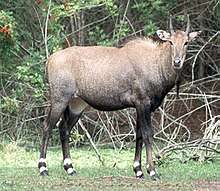 Male
Male Female
Female
Only males possess horns, though a few females may be horned as well. The horns are 15–24 centimetres (5.9–9.4 in) long but generally shorter than 30 centimetres (12 in).[7] Smooth and straight, these may point backward or forward.[36] The horns of the nilgai and the four-horned antelope lack the ringed structure typical of those of other bovids.[37]
The maximum recorded length of the skull is 376 millimetres (14.8 in). The dental formula is 0.0.3.33.1.3.3. The milk teeth are totally lost and the permanent dentition completed by three years of age. The permanent teeth get degraded with age, showing prominent signs of wear at six years of age. The nilgai has sharp ears and eyes,[38] though its sense of smell is not as acute.[39]
Ecology and behavior
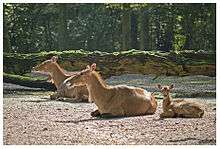
The nilgai is diurnal (active mainly during the day). A 1991 study investigated the daily routine of the antelope and found feeding peaks at dawn, in the morning, in the afternoon and during the evening.[40] Females and juveniles do not interact appreciably with males, except during the mating season. Groups are generally small, with ten or fewer individuals, though groups of 20 to 70 individuals can occur at times.[30] In a 1980 study in the Bardiya National Park (Nepal), the average herd size was of three individuals;[41] In a 1995 study in the Gir National Park (Gujarat, India), herd membership varied with season.[42] However, three distinct groupings are formed: one or two females with young calves, three to six adult and yearling females with calves, and male groups with two to 18 members.[43]
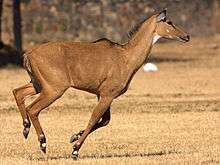
Typically tame, the nilgai may appear timid and cautious if harassed or alarmed; instead of seeking cover like duikers it would flee up to 300 metres (980 ft)-or even 700 metres (2,300 ft) on galloping-away from the danger.[44] Though generally quiet, nilgai have been reported to make short guttural grunts when alarmed, and females to make clicking noises when nursing young.[43][45] Alarmed individuals, mainly juveniles below five months, give out a coughing roar (whose pitch is highest in case of the juveniles) that lasts half a second, but can be heard by herds less than 500 metres (1,600 ft) away and responded to similarly.[2]
Fights take place in both sexes and involve pushing their necks against each other or ramming into one another using horns. Fights can be gory; despite the protective skin deep, lacerated wounds and even deaths might occur.[2] Display behaviour focuses on the throat patch and the beard, and threatening opponents by pointing the horns toward them. A young male was observed making a submissive display in the Sariska Reserve by kneeling before an adult male, who stood erect.[43] The nilgai mark their territories by forming dung piles as much as 50 centimetres (20 in) in radius. The defecation process is elaborate-the antelope stands with his legs about a metre apart, with the rump lowered and the tail held almost vertical; it stays in the same posture for at least ten seconds after relieving itself. The process is not as elaborate in the females as it is in the males.[44]

In India, the nilgai shares its habitat with the four-horned antelope, chinkara, chital and blackbuck; its association with the gaur and the water buffalo is less common.[2] In the Ranthambore National Park (Rajasthan, India) the nilgai and the chinkara collectively prefer the area rich in Acacia and Butea species, while the sambar deer and the chital preferred the forests of Anogeissus and Grewia species.[46] In India, the Indian tiger and the lion may prey on the nilgai but they are not significant predators of this antelope.[46] Leopards prey on the nilgai, though they prefer smaller prey.[47] Dholes generally attack juveniles.[2] Other predators include wolves[48] and striped hyenas.[2]
Diet
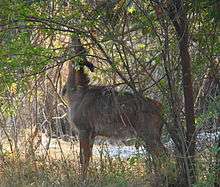
Herbivores, the nilgai prefer grasses and herbs; woody plants are commonly eaten in the dry tropical forests of India. Studies suggest they may be browsers[41] or mixed feeders[49] in India, whereas they are primarily grazers in Texas.[44] The nilgai can tolerate interference by livestock and degradation of vegetation in its habitat better than deer,[44] possibly because they can reach high branches and do not depend on surface vegetation.[43] The sambar deer and nilgai in Nepal have similar dietary preferences.[41] Diets generally suffice in protein and fats.[50] The protein content of the nilgai's should be at least seven percent.[51] The nilgai can survive for long periods without water and do not drink regularly even in summer.[2][52] However, a nilgai died in Dwarka (India) allegedly due to the heat wave and acute shortage of water.[53]
A 1994 study of the nilgai's diet in the Sariska Reserve revealed its preference for herbs and grasses; grasses became more important in the rainy season, while during winter and summer it fed additionally on flowers (Butea monosperma), foliage (Anogeissus pendula, Capparis sepiaria, Grewia flavescens and Zizyphus mauritiana), pods (Acacia nilotica, A. catechu and A. leucophloea) and fruits (Zizyphus mauritiana).[43] Preferred grass species include Cenchrus species, Cynodon dactylon, Desmostachya bipinnata, Scirpus tuberosus and Vetiveria zizanoides. Woody plants eaten include Acacia nilotica, A. senegal, A. leucophloea, Clerodendrum phlomidis, Crotalaria burhia, Indigofera oblongifolia, Morus alba and Zizyphus nummularia; herbs favoured are Cocculus hirsutus, Euphorbia hirta and Sida rhombifolia.[54][55][56] Seeds of Paspalum distichum occurred in the dung of nilgai most of the year; Acacia nilotica and Prosopis juliflora seeds were discovered in the dry season and those of Echinochloa crusgalli during the monsoon.[57]
Reproduction

Observations of females in southern Texas revealed that ovaries are developed by two years of age and the first birth takes place typically a year later, though in a few cases females as young as one-and-a-half years may mate successfully.[30] Females can breed again around a year after parturition.[2] Males in the same location were found to have active testes by the age of three years, that matured considerably by the next year.[58] Males become sexually active at four or five years. Mating may occur throughout the year, with peaks of three to four months. The time of the year when these peaks occur varies geographically. In Texas, a peak is apparent from December to March.[35] In Bharatpur National Park (Rajasthan, India) the breeding season is from October to February, peaking in November and December. The Sariska reserve witnesses a similar peak in December and January.[43]
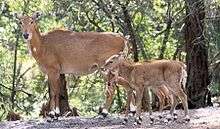
In the mating season, rutting males move about in search of females in oestrus.[43] Males become aggressive and fight among themselves for dominance. These fights are characterised by displays of the enlarged chest, the throat patch and the beard while holding the head upright; and threatening the opponent by running with the horns pointed toward him and circling him.[44][59] The victorious bull would protect the vicinity of the targeted female from other males. The courtship typically lasts for 45 minutes. The male, stiff and composed, approaches the receptive female, who keeps her head low to the ground and may slowly walk forward. The male licks her genitalia, upon which the female holds her tail to a side and the male gives out a flehmen response. Finally, the male pushes his chest against her rump, and mounts her.[44]
Gestation lasts eight to nine months, following which a single calf or twins (even triplets at times) are born. In a 2004 study in the Sariska reserve, twins accounted for as high as 80 percent of the total calf population.[43] Births peak from June to October in the Bharatpur National Park, and from April to August in southern Texas. Calves are precocial; they are able to stand within 40 minutes of birth, and forage by the fourth week.[7] Pregnant females isolate themselves before giving birth. As typical of several bovid species, nilgai calves are kept in hiding for the first few weeks of their lives. This period of concealment can last as long as a month in Texas.[44] Calves, mainly males, bicker playfully by neck-fighting.[40] Young males would leave their mothers at ten months to join bachelor groups.[31] The lifespan of the nilgai is typically ten years in Texas.[30]
Habitat and distribution
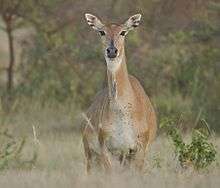

Nilgai prefer areas with short bushes and scattered trees in scrub forests and grassy plains. They are common in agricultural lands, but hardly occur in dense woods. In southern Texas, it roams in the prairies, scrub forests and oak forests. It is a generalist animal—it can adapt to a variety of habitats.[2] Though sedentary and less dependent on water, nilgai may desert their territories if all water sources in and around it dry up.[44] Territories in Texas are 0.6 to 8.1 square kilometres (0.23 to 3.13 sq mi) large.[2]
This antelope is endemic to the Indian subcontinent: major populations occur in India, Nepal and Pakistan, whereas it is extinct in Bangladesh. Significant numbers occur in the Terai lowlands in the foothills of the Himalayas; the antelope is abundant across northern India.[60] The Indian population was estimated at one million in 2001.[1] The nilgai were first introduced to Texas in the 1920s and the 1930s in a 6,000 acres (2,400 ha) large ranch near the Norias Division of the King Ranch, one of the largest ranches in the world. The feral population saw a spurt toward the latter part of the 1940s, and gradually spread out to adjoining ranches.[61]
_bull_(19725141044).jpg)
Population densities show great geographical variation across India. Density can be as low as 0.23 to 0.34 individuals per km2 in the Indravati National Park (Chhattisgarh)[62] and 0.4 individuals per km2 in the Pench Tiger Reserve (Madhya Pradesh)[63] or as high as 6.60 to 11.36 individuals per km2 and Ranthambhore National Park and 7 individuals per km2 in Keoladeo National Park (both in Rajasthan).[64] Seasonal variations were noted in the Bardiya National Park (Nepal) in a 1980 study; the density 3.2 individuals per km2 during the dry season and 5 per km2 in April (the start of the dry season).[41] In southern Texas, densities were found to be nearly 3–5 individuals per km2 in 1976.[2]
Historic notes mention nilgai in southern India, but these may have been feral:[65]
I believe that the Coimbatore and Salem collectorates are almost the only places in Southern India, in which nil-gai are to be found. It is difficult to account for the animals being thus so widely divided from their usual haunts unless as has been generally supposed, these Southern specimens are the progeny of a semi-domesticated herd, which, at some by-gone period, had escaped from the preserve of a native potentate.
— Andrew Cooke McMaster (Notes on Jerdon's Mammals of India, 1871)
Threats and conservation
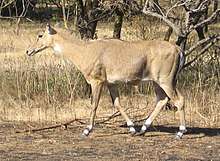
The nilgai is categorised as of Least Concern by the International Union for the Conservation of Nature and Natural resources (IUCN).[1] While it is common in India, the nilgai occurs sparsely in Nepal and Pakistan.[60] The major reasons behind its decimation in these two countries and extinction in Bangladesh are rampant hunting, deforestation and habitat degradation in the 20th century. As of 2008, the feral population in Texas was nearly 37,000.[1] Wild populations also exist in the US states of Alabama, Florida and Mississippi and the Mexican state of Tamaulipas, where they have escaped from private exotic ranches. The population around the Texas-Mexico border is estimated to be around 30,000 (as of 2011).[66]
In India, the nilgai is protected under Schedule III of the Wildlife Protection Act of 1972.[67] Major protected areas for the nilgai across India include: Gir National Park (Gujarat); Bandhavgarh National Park, Bori Wildlife Sanctuary, Kanha National Park, Pachmarhi Biosphere Reserve, Panna Tiger Reserve, Pench Tiger Reserve, Sanjay National Park, Satpura National Park (Madhya Pradesh); Tadoba Andhari Reserve (Maharashtra); Kumbhalgarh Wildlife Sanctuary, Sultanpur National Park in Gurgaon, Ranthambore National Park and Sariska Tiger Reserve (Rajasthan).[68]
Interactions with humans

Remains of nilgai have been excavated at Pandu Rajar Dhibi (West Bengal, India), suggesting that they were domesticated or hunted in eastern India in the Neolithic period (6500–1400 BCE)[69] and during the Indus Valley Civilisation (3300–1700 BCE) in the Indian subcontinent.[70][71] There is a reference to the nilgai in the Aitareya Brahmana (a Hindu religious text dated 500–1000 BCE), where one of the Prajapatis (progenitor god) is said to have assumed the form of a nilgai:[72]
Prajapati desired his own daughter ... Having become a nilgai bull he approached her who had become a nilgai cow ... The gods saw him and said: "Prajapati is doing a deed that is not done".
.jpg)
Nilgai are extensively featured in paintings, dagger hilts and texts from the Mughal era (16th to 19th centuries);[73][74] their representation, however, is less frequent than that of horses and camels.[75] On being disturbed while hunting nilgai, the Mughal emperor Jahangir recorded his ire:[76]
Suddenly a groom and two bearers appeared, and the nilgai escaped. In a great rage, I ordered them to kill the groom on the spot and hamstring the bearers and mount them on asses and parade them through the camp.
For centuries Indian villagers have associated the nilgai with the cow, a sacred animal revered by Hindus, and the name ("gai" means "cow" in Hindi) indicates the similarity they saw with the cow.[31][77] The nilgai is rarely consumed by Hindus due to its religious significance. Tribes such as the Bishnois traditionally take care of wild animals like the nilgai.[78] The nilgai was not widely hunted until the 20th century, when habitat degradation and poaching became rampant.[79][80] The meat of nilgai is said to be lighter and milder flavoured than blackbuck meat.[36][81]
Culling and conservation
The populations of nilgai in India are so large that farmers in the states of Bihar, Chhattisgarh, Haryana, Madhya Pradesh, Maharashtra, Rajasthan and Uttar Pradesh have pleaded to the government to cull them. Nilgai herds raid and trample crop fields across these states,[82][83] often causing food shortages.[84][85] Farmers use live electric wires to guard their farms, which kills other animals as well.[86] Farmers in Neemuch (Madhya Pradesh) went on a hunger strike in 2015 demanding compensation for the damage caused by nilgai.[87] Although blackbuck cause a similar problem, the damage caused by them is significantly lower as they merely break off young shoots.[88][89] A 1990 study suggested culling, building enclosures for the antelopes and fencing off agricultural areas as remedies.[88]
The governments of Bihar,[84] Maharashtra[90] and Uttarakhand[91] have urged the Government of India to declare the nilgai as vermin; the proposal has been implemented in Bihar, where nilgai can now be hunted to minimise the damages incurred by locals.[84] The Uttar Pradesh government has given farmers and firearm licence holders the right to cull the animals.[92] However, animal rights activists in various parts of India were unhappy with the decision.[93] Shivanshu K. Srivastava, a columnist and social activist, wrote that "The culling of nilgais (blue bulls) in Bihar in July 2016 was so deplorable that it doesn't need any justification. The excuse given for this slew by the State government, the then environment minister Prakash Javadekar and the judiciary is so illogical that it mocks all the solutions available to stop the nilgais from destroying the farms. We live in the 21st century and culling is only the very last option we have. The farmers can either opt for fencing around the farmlands or if it's unaffordable, then the government can give ordinances to relocate them to the forests."[94][95] The state governments have attempted other initiatives to curb the nilgai: in November 2015, the Rajasthan government came up with a proposal to allow shooting nilgai with non-lethal darts to inhibit fertilisation in their bodies, so as to regulate their increasing populations.[96] As the name "nilgai" appeals to the religious sentiments of Hindus, the Government of Madhya Pradesh has sought to officially rename it as rojad (Hindi for "forest antelope") and the Government of Haryana to rename it as roze in a bid to make their culling acceptable.[97][98][99]
In September 2019, a video surfaced of a nilgai being buried alive with an excavator in Bihar as part of the culling. The state forest department has claimed to have begun an investigation to find those responsible.[100]
A 1994 study drew attention to the ecological value provided by the nilgai in ravines lining the Yamuna River. In summer, the faeces of the antelope contained nearly 1.6 percent nitrogen, that could enhance the quality of the soil up to a depth of 30 centimetres (12 in). Seeds in the droppings could easily germinate and assist in afforestation.[101]
References
- Mallon, D.P. (2008). "Boselaphus tragocamelus". IUCN Red List of Threatened Species. 2008. Retrieved 29 March 2009.CS1 maint: ref=harv (link) Database entry includes a brief justification of why this species is of least concern.
- D.M. Leslie (2008). "Boselaphus tragocamelus (Artiodactyla: Bovidae)". Mammalian Species. 813: Number 813: pp. 1–16. doi:10.1644/813.1.
- The daily star,23 January 2019, page 2
- "Nilgai". Merriam-Webster Dictionary. Retrieved 8 March 2016.
- Gray, J.E. (1850). "Synopsis of the species of antelopes and strepsiceres, with descriptions of new species". Proceedings of the Zoological Society of London. 18: 111–146.
- Pilgrim, G.E. (1939). "The fossil bovidae of India". Memoirs of the Geological Survey of India, New Series. 26: 1–356.
- Padhi, S.; Panigrahi, G.K.; Panda, S. (2004). The Wild Animals of India. Delhi: Biotech Books. pp. 26–7. ISBN 978-81-7622-106-1.
- Wilson, D.E.; Reeder, D.M., eds. (2005). Mammal Species of the World: A Taxonomic and Geographic Reference (3rd ed.). Johns Hopkins University Press. ISBN 978-0-8018-8221-0. OCLC 62265494.
- Parsons, J. (1745). "An account of a quadruped brought from Bengal and now to be seen in London". Philosophical Transactions. 43 (476): 465–7. doi:10.1098/rstl.1744.0089.
- Renshaw, G. (1907). Final Natural History Essays. Cambridge, England: Sherratt & Hughes. pp. 120–1.
- "Boselaphus tragocamelus". Integrated Taxonomic Information System. Retrieved 8 March 2016.
- "Boselaphus". Merriam-Webster Dictionary. Retrieved 8 March 2016.
- Reichenbach, H.G.L. (1845). "Die Vollständigste Naturgeschichte des In-und Auslandes". Expedition der Vollständigsten Naturgeschichte: 141–2.
- Allard, M.W.; Miyamoto, M.M.; Jarecki, L.; Kraus, F.; Tennant, M.R. (1992). "DNA systematics and evolution of the artiodactyl family Bovidae". Proceedings of the National Academy of Sciences of the United States of America. 89 (9): 3972–6. Bibcode:1992PNAS...89.3972A. doi:10.1073/pnas.89.9.3972. PMC 525613. PMID 1570322.
- Hassanin, A.; Douzery, E. J. P. (1999). "Evolutionary affinities of the enigmatic saola (Pseudoryx nghetinhensis) in the context of the molecular phylogeny of Bovidae". Proceedings of the Royal Society B: Biological Sciences. 266 (1422): 893–900. doi:10.1098/rspb.1999.0720. PMC 1689916. PMID 10380679.
- Brain, C.K. (1981). The Hunters or the Hunted? : An Introduction to African Cave Taphonomy. Chicago, US: University of Chicago Press. p. 167. ISBN 978-0-226-07089-6.
- Pitra, C.; Furbass, R.; Seyfert, H.M. (1997). "Molecular phylogeny of the tribe Bovini (Mammalia: Artiodactyla): alternative placement of the Anoa". Journal of Evolutionary Biology. 10 (4): 589–600. doi:10.1046/j.1420-9101.1997.10040589.x.
- Bibi, F. (2007). "Origin, paleoecology, and paleobiogeography of early Bovini". Palaeogeography, Palaeoclimatology, Palaeoecology. 248 (1): 60–72. Bibcode:2007PPP...248...60B. doi:10.1016/j.palaeo.2006.11.009.
- Solounias, N. (1990). "A new hypothesis uniting Boselaphus and Tetracerus with the Miocene Boselaphini (Mammalia, Bovidae) based on horn morphology". Annales Musei Goulandris. 8: 425–39.
- Kostopoulus, D.S. (2005). "The Bovidae (Mammalia, Artiodactyla) from the late Miocene of Akkas¸dag˘i, Turkey". Geodiversitas. 27: 747–91.
- Von Zittel, Karl A. (1925). Text-book of Palaeontology. Volume III. Mammalia. London: Macmillan and Co. pp. 211–214.
- Johnston, Anne R; Anthony, Nicola M (2012). "A multi-locus species phylogeny of African forest duikers in the subfamily Cephalophinae: Evidence for a recent radiation in the Pleistocene". BMC Evolutionary Biology. 12: 120. doi:10.1186/1471-2148-12-120. PMC 3523051. PMID 22823504.
- Benefit, B.R.; Pickford, M. (April 1986). "Miocene fossil cercopithecoids from Kenya". American Journal of Physical Anthropology. 69 (4): 441–64. doi:10.1002/ajpa.1330690404.
- Zhang, Z. (2005). "Late Miocene Boselaphini (Bovidae, Artiodactyla) from Fugu, Shaanxi Province, China". Vertebrata PalAsiatica. 43 (3): 208–18.
- WoldeGabriel, G. (2009). Haile-Selassie, Y. (ed.). Ardipithecus Kadabba : Late Miocene Evidence from the Middle Awash, Ethiopia. Berkeley: University of California Press. pp. 289–90. ISBN 978-0-520-25440-4.
- Prasad, K.N. (1996). "Pleistocene cave fauna from peninsular India" (PDF). Journal of Cave and Karst Studies. 58: 30–4.
- Murty, M.L.K. (2010). "Ethnoarchaeology of the Kurnool cave areas, South India". World Archaeology. 17 (2): 192–205. doi:10.1080/00438243.1985.9979962.
- Patnaik, Rajeev; Badam, G. L.; Murty, M. L. K. (2008-12-01). "Additional vertebrate remains from one of the Late Pleistocene—Holocene Kurnool Caves (Muchchatla Chintamanu Gavi) of South India". Quaternary International. Multiple Approaches to South Asian Paleoanthropology: A Tribute to Gudrun Corvinus. 192 (1): 43–51. Bibcode:2008QuInt.192...43P. doi:10.1016/j.quaint.2007.06.018.
- Rafferty, J.P., ed. (2011). Grazers (1st ed.). New York, US: Britannica Educational Pub. pp. 83–4. ISBN 978-1-61530-336-6.
- Schmidly, D.J. (2004). The Mammals of Texas (Revised ed.). Austin, Texas (US): University of Texas Press. pp. 283–4. ISBN 978-1-4773-0886-8.
- Eldredge, N., ed. (2002). Life on Earth : An Encyclopedia of Biodiversity, Ecology, and Evolution. Santa Barbara, California (US): ABC-CLIO. p. 192. ISBN 978-1-57607-286-8.
- Ranjitsinh, M.K. (1987). "Unusual coloration of nilgai (Boselaphus tragocamelus)". Journal of the Bombay Natural History Society. 84: 203.
- Smielowski, J. (1987). "Albinism in the Blue bull or Nilgai Boselaphus tragocamelus (Pallas, 1766)". Journal of the Bombay Natural History Society. 84: 427–428.
- Koppiker, B.R.; Sabnis, J.H. (1981). "Aids to the identification of artiodactylan hairs with general comments on hair structure". Journal of the Bombay Natural History Society. 78: 299–302.
- Deal, K.H. (2011). Wildlife and natural resource management (3rd ed.). Clifton Park, New York: Delmar Cengage Learning. p. 155. ISBN 978-1-4354-5397-5.
- Lundeberg, A.; Seymour, F. (1910). The Great Roosevelt African Hunt and the Wild Animals of Africa. Chicago, US: D. B. McCurdy. p. 351. ISBN 978-5-519-33652-9.
- Tiwari, S.K. (1998). National Parks of Madhya Pradesh : State of Bio Diversity and Human Infringement (1st ed.). New Delhi, India: APH Pub. Corp. pp. 110–2. ISBN 978-81-7024-950-4.
- Goetze, J.R. (1998). The Mammals of the Edwards Plateau, Texas. Lubbock, Texas (US): Museum of Texas Tech University. p. 242. ISBN 978-0-9640188-7-7.
- Brown, C.E. (1936). "Rearing wild animals in captivity, and gestation periods". Journal of Mammalogy. 17 (1): 10–3. doi:10.2307/1374541. JSTOR 1374541.
- Oguya, B. R. O.; Eltringham, S. K. (1991). "Behaviour of nilgai (Boselaphus tragocamelus) antelope in captivity". Journal of Zoology. 223 (1): 91–102. doi:10.1111/j.1469-7998.1991.tb04751.x.
- Dinerstein, E. (1979). "An ecological survey of the Royal Karnali-Bardia Wildlife Reserve, Nepal. Part II: Habitat/animal interactions". Biological Conservation. 16 (4): 265–300. doi:10.1016/0006-3207(79)90055-7.
- Khan, J.A.; Chellam, R.; Johnsingh, A.J.T. (1995). "Group size and age-sex composition of three major ungulate species in Gir Lion Sanctuary, Gujarat, India". Journal of the Bombay Natural History Society. 92 (295–302).
- Sankar, K.; Johnsingh, A.J.T.; Acharya, B. (2004). "Blue bull or nilgai". Envis Bulletin (Wildlife and Protected Areas) : Ungulates of India. 7 (1): 29–40. ISSN 0972-088X.
- Sheffield, W.J. (1983). "Food habits of nilgai antelope in Texas". Journal of Range Management. 36 (3): 316–22. doi:10.2307/3898478. JSTOR 3898478.
- Goldman, J.E.; Stevens, V.J. (January 1980). "The birth and development of twin Nilgai Boselaphus tragocamelus at Washington Park Zoo, Portland". International Zoo Yearbook. 20 (1): 234–40. doi:10.1111/j.1748-1090.1980.tb00982.x.
- Bagchi, S.; Goyal, S. P.; Sankar, K. (2003). "Niche relationships of an ungulate assemablage in a dry tropical forest". Journal of Mammalogy. 84 (3): 981–8. doi:10.1644/BBa-024.
- Hayward, M.W.; Henschel, P.; O'Brien, J.; Hofmeyr, M.; Blame, G.; Kerley, G.I.H. (2006). "Prey preferences of the leopard (Panthera pardus)". Journal of Zoology. 270 (2): 298–313. doi:10.1111/j.1469-7998.2006.00139.x.
- Jethva, B.D.; Jhala, Y.V. (2004). "Foraging ecology, economics and conservation of Indian wolves in the Bhal region of Gujarat, western India". Biological Conservation. 116 (3): 351–357. doi:10.1016/S0006-3207(03)00218-0.
- Haque, N. (1990). "Study on the ecology of wild ungulates of Keoladeo National Park Bharatpur, Rajasthan". PHD Thesis, Centre for Wildlife and Ornithology, Aligarh Muslim University: 1–308.
- Khan, A.A. (1979). "A note on nutritive value of forages for nilgai". Pakistan Journal of Forestry. 29 (3): 199–202. ISSN 0030-9818.
- Priebe, J.C; Brown, R.D (1987). "Protein requirements of subadult nilgai antelope". Comparative Biochemistry and Physiology A. 88 (3): 495–501. doi:10.1016/0300-9629(87)90070-3.
- Prater, S.H. (1934). "The Wild Animals of the Indian Empire and the problems of their preservation. Part 2". Journal of the Bombay Natural History Society. 37: 59–96.
- Bureau, Mail Today (28 May 2015). "Delhi's heat wave kills Nilgai in Dwarka". India Today. Retrieved 9 March 2016.
- Solanki, G.S.; Naik, R.M. (1998). "Grazing interactions between wild and domestic herbivores". Small Ruminant Research. 27 (3): 231–5. doi:10.1016/S0921-4488(97)00038-2.
- Mirza, Z.B.; Khan, M.A. (1975). "Study of distribution, habitat and food of nilgai Boselaphus tragocamelus in Punjab". Pakistan Journal of Zoology. 7: 209–14.
- Sankar, K.; Vijayan, V. S. (1992). "Notes on the food habits of nilgai Boselaphus tragocamelus". Journal of the Bombay Natural History Society. 89: 115–116.
- Middleton, B.A.; Mason, D.H. (1992). "Seed herbivory by nilgai, feral cattle, and wild boar in the Keoladeo National Park, India". Biotropica. 24 (4): 538–43. doi:10.2307/2389017. JSTOR 2389017.
- Lochmiller, R.L.; Sheffield, W.J. (1989). "Reproductive traits of male nilgai antelope in Texas". The Southwestern Naturalist. 34 (2): 276–8. doi:10.2307/3671738. JSTOR 3671738.
- Cowan, I. McT.; Geist, V. (1961). "Aggressive behavior in deer of the genus Odocoileus". Journal of Mammalogy. 42 (4): 522–6. doi:10.2307/1377372. JSTOR 1377372.
- Mallon, D.P.; Kingswood, S.C.; East, R. (1900). Antelopes : global survey and regional action plans. Gland, Switzerland: IUCN. p. 189. ISBN 978-2-8317-0594-1.
- Teer, James G. (2008). It's a Long Way from Llano : The Journey of a Wildlife Biologist (1st ed.). College Station, Texas (US): Texas A & M University Press. pp. 98–104. ISBN 978-1-60344-068-4.
- Pandey, R.K. (1988). "Habitat utilization and diurnal activity pattern in Indian wild buffalo (Bubalus bubalis Linn.) in Indravati Wildlife National Park, India: a study of habitat/animal interactions". Journal of Tropical Ecology. 4: 269–80.
- Biswas, S.; Sankar, K. (2002). "Prey abundance and food habit of tigers (Panthera tigris tigris) in Pench National Park, Madhya Pradesh, India". Journal of Zoology. 256 (3): 411–20. doi:10.1017/S0952836902000456.
- Bagchi, S.; Goyal, S.P.; Sankar, K. (2004). "Herbivore density and biomass in a semi-arid tropical dry deciduous forest of western India". Journal of Tropical Ecology. 20 (4): 475–8. doi:10.1017/S026646740400166X.
- McMaster, A.C. (1871). Notes on Jerdon's Mammals of India. Madras (Chennai), India: Higginbothams. pp. 124–125.
- Cárdenas-Canales, E.M.; Ortega-Santos, J.A.; Campbell, T.A.; García-Vázquez, Z.; Cantú-Covarrubias, A.; Figueroa-Millán, J.V.; DeYoung, R.W.; Hewitt, D.G.; Bryant, F.C. (2011). "Nilgai antelope in northern Mexico as a Possible Carrier for Cattle Fever Ticks and Babesia bovis and Babesia bigemina" (PDF). Journal of Wildlife Diseases. 47 (3): 777–9. doi:10.7589/0090-3558-47.3.777. PMID 21719852.
- "Environment ministry may allow hunting of 'nuisance' wild animals". Down to Earth. 11 June 2015. Retrieved 11 March 2016.
- Belsare, D.K. (2011). Vanishing Roar of Bengal Tigers. Pittsburgh, Pennsylvania (US): RoseDog Books. pp. 17–29. ISBN 978-1-4349-8509-5.
- Sharma, R.S. (2007). Material Culture and Social Formations in Ancient India (2nd ed.). New Delhi: Macmillan India. p. 129. ISBN 978-0-230-63380-3.
- Mallory, J.P.; Adams, D.Q. (1997). Encyclopedia of Indo-European Culture (1st ed.). London: Fitzroy Dearborn. p. 256. ISBN 978-1-884964-98-5.
- Joglekar, Pramod P.; Goyal, Pankaj (2011). "Faunal Remains from Shikarpur, a Harappan Site in Gujarat, India". Iranian Journal of Archaeological Studies. 1: 16–25.
- Parpola, A. (2015). The Roots of Hinduism: The Early Aryans and the Indus Civilization. Oxford, UK: Oxford University Press. p. 247. ISBN 978-0-19-022692-3.
- Moore, C. (2013). Ekhtiar, M. (ed.). Art of the Islamic World : A Resource for Educators. New York, US: Metropolitan Museum of Art. p. 158. ISBN 978-0-300-19181-3.
- Newton, D. (1987). The Pacific Islands, Africa, and the Americas. New York, US: Metropolitan Museum of Art. p. 145. ISBN 978-0-87099-461-6.
- Alexander, D.; Pyhrr, S.W.; Kwiatkowski, W. (2015). Islamic Arms and Armor: in The Metropolitan Museum of Art. New York, US: Metropolitan Museum of Art. p. 212. ISBN 978-1-58839-570-2.
- Eraly, Abraham (2007). The Mughal World : Life in India's Last Golden Age. New Delhi, India: Penguin Books. p. 259. ISBN 978-0-14-310262-5.
- Lewis, M. (2003). Inventing Global Ecology : Tracking the Biodiversity Ideal in India, 1945–1997. New Delhi, India: Orient Longman. p. 286. ISBN 978-81-250-2377-7.
- Thomas, R. (2 March 2016). "This vet treats 700 wild patients a year!". The Times of India. Retrieved 9 March 2016.
- Armstrong, M. (2007). Wildlife and Plants: Volume 12 (3rd ed.). New York, US: Marshall Cavendish. pp. 718–9. ISBN 978-0-7614-7705-1.
- Brendt, R. (2013). Worldwide Hunting Adventures: Memories of the Hunt. Bloomington, Indiana (US): Xlibris Corporation. pp. 118–22. ISBN 978-1-4836-4617-6.
- Green, A. (2005). Field Guide to Meat : How to Identify, Select and Prepare Virtually Every Meat, Poultry and Game Cut. Philadelphia, Pennsylvania: Quirk Books. p. 264. ISBN 978-1-59474-017-6.
- Goyal, S.K.; Rajpurohit, L.S. (2000). "Nilgai, Boselaphus tragocamelus – a mammalian crop pest around Jodhpur". Uttar Pradesh Journal of Zoology. 20 (1): 55–9. ISSN 0256-971X.
- Kumar, A. (6 March 2016). "Now, Bihar farmers hope for a reprieve from Nilgai". Deccan Herald. Retrieved 10 March 2016.
- Vishnoi, A. (15 December 2015). "Centre allows Bihar to cull Nilgai herds and wild pigs; declares them 'vermin'". The Economic Times. Retrieved 10 March 2016.
- Dabas, H. (29 October 2015). "As Nilgai destroy fields, cane farmers urged to grow pulses". The Times of India. Retrieved 9 March 2016.
- Lenin, J. (27 December 2014). "India: Changing the nilgai's name as a management strategy". The Guardian. Retrieved 9 March 2016.
- Times News Network (20 December 2015). "Nilgai menace drives Neemuch farmers to edge". The Times of India. Retrieved 9 March 2016.
- Chauhan, N.P.S.; Singh, R. (1990). "Crop damage by overabundant populations of nilgai and blackbuck in Haryana (India) and its management (Paper 13)". Proceedings of the Fourteenth Vertebrate Pest Conference 1990: 218–20.
- Chauhan, N.P.S.; Sawarkar, V.B. (1989). "Problems of over-abundant populations of 'Nilgai' and 'Blackbuck' in Haryana and Madhya Pradesh and their management". The Indian Forester. 115 (7).
- Kulkarni, D. (22 February 2016). "Maharashtra government wants nilgai, wild boar to be declared vermin". Daily News and Analysis. Retrieved 10 March 2016.
- Sharma, S. (31 July 2015). "U'khand asks MoEF to declare wild boar, nilgai vermin". The Times of India. Retrieved 9 March 2016.
- Akhef, M. (30 June 2015). "Govt allows culling of nilgai, wild boar". The Times of India. Retrieved 9 March 2016.
- Singh, V.A. (27 February 2016). "Animal rights groups unhappy with government's decision to declare nilgai as vermin". Daily News and Analysis. Retrieved 10 March 2016.
- India, Metro. "Animals ought to have fundamental rights". Metroindia. Retrieved 2017-03-02.
- "Animals, too, have the right to live". www.observerbd.com. Retrieved 2017-03-02.
- Mazoomdaar, J. (12 November 2015). "A new sport in Rajasthan: Shoot and save the nilgai". The Indian Express. Retrieved 9 March 2016.
- Ghatwai, M. (3 March 2016). "To save crops and legitimise killing nilgai, Madhya Pradesh renames it to 'rojad' in rulebooks". The Indian Express. Retrieved 10 March 2016.
- Kidwai, R. (1 March 2016). "Change nilgai name and cull it". The Telegraph. Retrieved 10 March 2016.
- "Haryana to change name of nilgai to roze". The Hindu. 18 March 2016. Retrieved 29 May 2016.
- "Brutal pictures surfaced from Bihar, Nilgai was buried alive". News Track. Retrieved 2019-09-03.
- Prajapati, M.C.; Singh, S. (1994). "A beneficial aspect of nilgai (Boselaphus tragocamelus) in scientifically utilised ravines – an observation". The Indian Forester. 120 (10).
External links


